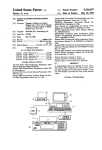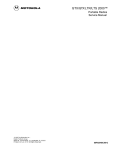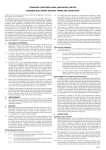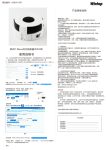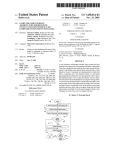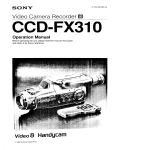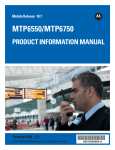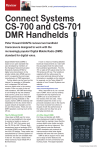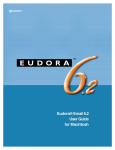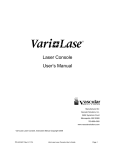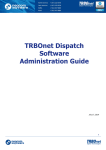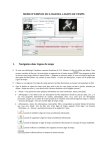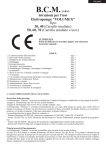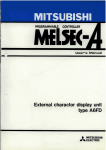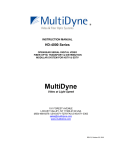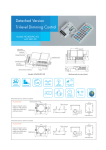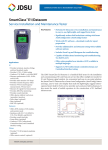Download Radio programming device with access to a remote database
Transcript
United States Patent [19] [11] [45] Shirley, Jr. et al. [54] RADIO PROGRAMIWING DEVICE WITH ACCESS TO A REMOTE DATABASE Tex. [73] Assignee: Motorola, Inc., Schaumburg, Ill. [21] Appl. No.: 175,002 [51] m. cl.5 .... .. [52] us. Cl. .................................... .. 455/67; 455/186; [58] Field Of Search ................ .. 455/186, 226, 67, 185 ............ .. H041! 17/00 455/226 [56] Systems 9000 Conventional 64 Mode Radio and Con Systems 9000 Conventional 32 Mode Radio and Con trol Head Programmer, dated Nov. 12, 1985. EEPROM Programmer (Instruction Manual No. 68P06088T60—0, published in 1984. Users Manual for Programming the Mostar NVR (Manual No. 68P80100W88-0, published in 1985. HT600 Programmer/‘Tuner User’s Manual (Manual SMARINET Standalone Field Programmer Model T5124A (Programming Information Guide 68P-81l 17E1 1-0, published in 1985. Systems 9000 Conventional Radio Programmer Opera tor’s Manual (Manual No. 68-80309B24-0, published in 1986. References Gted 1/ 1982 Miyasaka et al. ................. .. 455/ 186 Mears ................ .. 455/ 186 6/1985 4,739,486 4/ 1988 Soderbcrg et al. . 364/464 4,771,399 9/ 1988 Snowden ct al. 455/186 4,792,986 12/1988 455/186 Garner et al. .... .. , Systems 9000 Conventional Control Head Programmer Operator’s Manual, (Manual No. 68-80309B25-0, dated U.S. PATENT DOCUMENTS 4,310,924 4,525,865 May 22, 1990 No. 68P81045C55-2. Mar. 30, 1988 . . 4,927,789 trol Head Programmer, dated, Nov. 12, 1985. _ [75] Inventors: Thomas F. Shirley, Jr., Fort Worth; Eric S. Goldsmith, Watauga, both of [22] Filed: Patent Number: Date of Patent: OTHER PUBLICATIONS May 15, 1986). Systems 9000 Trunkcd Control Head Programmer Op erator’s Manual (Operator’s Manual No. 68-80309B 26-0, dated May 15, 1986. Primary Examiner-Joseph A. Orsino User Manual for the Motorola Trunking Code Manage Assistant Examiner-Frank M. Scutch, III Attorney, Agent, or Firm—Steven G. Parmelee ment System Remote Field Programming Radio Unit Code Plugs, dated Jun. 1, 1986. User Manual for the Motorola Trunking Code Manage A programming station for use in programming and " ment System Remote Field Programming Read/ Display Radio Unit Code Plugs, dated July 1, 1986. User Manual for the Motorola Trunking Code Manage ment System Remote Field Programming Read/ Display Radio Unit Code Plugs, dated November 1, 1986. The MC MiéiJFiéliFi-bii-Méi Handbook, dated 1985 by Motorola GmbH Taunusstein. Systems 9000 Trunked Radio Programmer, dated 1986 by Motorola, Inc. [57] ABSTRACT servicing two-way radios. The station allows a user to read stored radio control and radio feature parameters as stored in either a radio or an archive ?le. The station allows the user to modify at least some of the radio feature parameters, and to access a remote central unit that allows modi?cation of the remaining radio feature parameters. The changed parameters can then be merged as necessary and stored in the radio and/or an archive ?le. Systems 9000 Conventional Options Programmer 1985, 3 Claims, 4 Drawing Sheets > Motorola, Inc. 1/4 MODEM RIB + P0 FER US. Patent May 22,1990 19 4,927,789 Sheet 1 of 4 PRINTER 16 / w] RIB 12 + POWER - SOURCE K [)F MODE J [-1 m1 m1 [ 1 [st-1] @2111 [VOLUME] [ ] DE] FIG. 1 / (r FIG. 2 21 / I 1 @@@1 EJEIE] EEJE] 20 23 / MODEL: / l /22 I lSELEDT FUNCTION KEY Fl-Fl?. I MAIN MENU — HELP - SERVICE: ALIGNMENT, SERVICE AIDS, AND BOARD REPLACEMENTS - GET SAVE PROGRAM CODEPLUG DATA FROEAALO DISK/CODEPLUG — CHANGE/VIEW/CREATE RADIO CODEPLUG — PRINT CODEPLUG DATA B53153 Il F9 - SETUP COMPUTER CONFIGURA‘HON F10- EXIT RADIO SERVICE SOFTWARE, RUURN T0 DOS F1 F2 F3 F4 F5 F6 F7 F8 F9 F10 HELP SERVICE GE!‘ CHANGE PRINT SEI'UP EXIT SAVE vn-zw © 1987 MOTOROLA, INC. 6 T0 005 \ J L@ US. Patent May 22, 1990 Sheet 3 of 4 4,927,789 21 r 1/ 1/ 22 1/ 23 w rsPEcTRII' MODEL: 057I<EA5JB9AI< CHANGE/VIEW: 'IRUNK ISELECTFIINUIION KEY FI-FIO. ' / ‘ V TRUNKING CONFIGURATION MENU I1 I I‘; - HELP 3 - PERSONALTIES: FLEEIWIDE, FAIISOFI', TOT. PHONE TYPE, CALL usr F5 - SYSTEMS: CONTROL CHANNEL, ID's, EI‘C. F6 - SYSTEM SCAN oPnoNs P7 - PHONE usn UST NAMES AND NUMBERS @ E3 - . F10- EXIT/RETURN T0 CHANGE/VIEW MENU F1 HELP F2 F3 F4 PERSONALITY @ F5 F6 F1 F8 SYSTEM SCAN PHONE F9 F10 EXIT oPIIoNs usr © 1987 MOTOROLA, INC. @ J c \ J \24 ' ‘ r 35 / 21 23 __ / 22 I I / / ‘ 1 SPECTRA ' MODEL: omcmasm ISEIECI'FUNCHON KEY FI-FIII ‘ /1 $18M 7 > E GET/SAVE MENU F1 - HELP F2 - READ DATA FROM RADIO OODEPLUG (REQUIRES RIB) F3 - GET CODEPLUG DATA FROM AROHNE DISK FILE F4 - GET TOMS OODEPLUG UPDATE DISK FILE F5 - CLONE OODEPLUG DATA TO ANOTHER RADIO Fl : SAVE CODEPLUG DATA TO ARCHIVE FILE DISK Fa - PROGRAM DATA INTO RADIO CODEPLUG (REQUIRES RIB) F9 _ FIO- EXIT / RETURN TO MAIN MENU F1 F2 F3 F4- F5 HELP READ GET GET CLONE CODEPLUG FILE ms RADIO L@ 1987 MOTOROLA, INC. L F6 F7 F8 ( SAVE PROGRAM FILE CODEPLUG \ \ 24 F9 FIO EXIT 1 4,927,789 2 ling at least some radio control functions as a function of RADIO PROGRAMMING DEVICE WITH ACCESS TO A REMOTE DATABASE the stored parameters. The device includes an appropriate coupling mecha nism to allow access to at least the memory in the radio, COPYRIGHT INFORMATION and a programming station for communicating with the radio via the coupling mechanism. The programming A portion of the disclosure of this patent document contains material that is subject to copyright protection. station allows an operator to access the memory and The copyright owner has no objection to the facsimile read the radio control parameters that are stored reproduction by anyone of the patent document or the therein, to change these radio control parameters, and patent disclosure, as it appears in the Patent and Trade l0 to store the changed and unchanged radio control pa mark O?ice patent ?le or records, but otherwise re rameters in the radio’s memory, such that future use of serves all copyright rights whatsoever. the radio will be governed by the newly stored parame TECHNICAL FIELD ters. BACKGROUND ART the memory of the radio. In another embodiment of the invention, the pro This invention relates generally to the programming 15 gramming station can also read, change, and store cer and servicing of two-way radios. tain radio feature parameters that may also be stored in In yet another embodiment, the programming station Two-way radios are becoming increasingly sophisti~ can receive new radio feature parameters that are main tained at a remote central unit, and combine that new cated. Many such radios now realize many operating functions and features through provision of an on-board information with other radio control and radio feature microprocessor For example, some models of the Spec parameters in an integrated form, and store the compos tra radio, manufactured by Motorola, Inc., do not in ite information in the memory of the radio. clude any internal adjustable components such as poten tiometers or coils. Instead, all RF and signaling parame 25 BRIEF DESCRIPTION OF THE DRAWINGS ters are controlled by an on-board microprocessor. FIG. 1 comprises a block diagram depiction of the These increasingly sophisticated radios have given rise invention as coupled to a two-way radio; to a concurrent need for a similarly sophisticated means FIG. 2 comprises a depiction of a main menu as pres of both initially programming such radios for intended service, and of servicing or reprogramming the radio in 30 ented at the programming station; FIG. 3 comprises a diagrammatic representation of a service shop. the functional capabilities of the programming station; At the same time, however, certain radio functions FIG. 4 comprises the trunking con?guration menu as are not properly controlled at the service shop or user level. For example, certain parameters that relate to the presented at station; operation of trunked radios are best maintained and 35 FIG. 5 comprises the get/save menu screen as pres controlled from a single central site. Since this central ented at the programming station; and site will usually maintain such information for a number of systems, the central site will likely be remote with respect to the radio that requires servicing. In the past, therefore, when system con?guration changes were required, the entire code plug contents for the radio FIG. 6 comprises a representation of the TCMS code plug update screen. 40 were down-loaded via modem from the central site and then programmed into the radio. The above process presents a number of problems. For example, this approach requires the central site to maintain many parameters that are not critical to the system. This can become a signi?cant burden. Also, as the number of parameters stored in the radio’s memory 45 BEST MODE FOR CARRYING OUT THE INVENTION Referring now to FIG. 1, the programming station, depicted generally by the numeral 10, operates in con junction with an appropriate two-way radio (11). The radio (11) connects to an appropriate power source (12) and the programming station (10) couples to the radio (11) through an appropriate coupling mechanism; in this case, a radio interface box (13). Each of these compo down-load each new con?guration increases as well. 50 nents will now be described in more detail in seriatim fashion. This represents both a time and cost issue. Further, as increases, the telephone line connect time required to radios become more complex (as described above), many of the radio’s parameters are not available to the central site, thereby rendering the prior art approach inapplicable. A need therefore exists for a radio programming device that can access a remote database for system critical information, and integrate that information into a radio in conjunction with other on-site programmable information. SUMMARY OF THE INVENTION These and other needs are substantially met through provision of the radio programming device disclosed The radio (11) may be, for example, a Spectra two way land mobile radio as manufactured and sold by Motorola, Inc. Such a radio has an internal micro 55 processor for controlling its radio control functions and its radio feature functions. (As used herein, “radio con trol functions” refers to radio speci?c performance parameters, ‘such as deviation, reference oscillator, transmit power, signaling deviation, and so forth. “Radio feature functions” refers to both user speci?c and system speci?c features, such as trunking system data, IDs, channel scan lists, telephone interconnect data, call number lists, and so forth.) The microprocessor in the radio communicates with herein. 65 other devices within the radio and external to the radio This device is intended for use with two-way radios on a serial bus. The radio interface box (13) functions to that have a memory for storing at least some radio con level shift the RS232 voltage level signals that are out trol parameters, and an internal computer for control put and received by the programming station (10) to an 3 4,927,789 4 appropriate signal level that is compatible with the access to four important service and programming radio’s serial bus interface. menus: service (32), get/save (33), change/view (34), and print (36). (Additional information regarding the The radio interface box (13) may be provided through use of Part No. 0l-80353A74. The cable be tween the radio interface box (13) and the radio (11) may be provided through use of Part No. 30-80369B73. The cable between the radio interface box (13) and the service function (32), the get/save (33) function and the print function (36) can be found in copending US. pa tent application Ser. No. 07/ 175,361 ?led on Mar. 30, 1988 and entitled Radio Component Replacement/Pro gramming Device, Ser. No. 07/175003 ?led on Mar. 30, of a Part No. 30-80369B71. All Of the above noted parts 1988 and entitled Radio Alignment/Programming De are manufactured and sold by Motorola, Inc. 10 vice, and Ser. No. 07/ 175,084 ?led on Mar. 30, 1988 and The programming station (10) can be comprised of an entitled Radio Programming Device, which applica IBM personal computer or compatible (14), which in tions are incorporated herein by this reference.) cludes at least one RS232 port, 512K RAM, and a DOS In general, the service function (32) comprises a mul 3.0 operating system. In addition, at least one disk drive tilevel menu routine that supports radio alignment, ad (16), a keyboard (17), a display screen for displaying vanced alignment, board replacement, and service aids alphanumeric information (18), a printer (19), and a functions. All service screens access the memory in the modem (20) should be provided. radio directly, and it is not necessary to read the radio’s Referring now to FIG. 2, most actions of the pro memory via the get/save function (33) before using the gramming station (10) are controlled through the use of service screens. All service screens use the same four formatted screen displays and the function keys ordinar dedicated screen sections described earlier. ily found on the keyboard (17) (i.e., F1-F10). In gen The get/save function (33) generally functions to eral, all screens provided at the programming station read radio control and radio feature parameters as programming station (10) may be provided through use (10) use an identical format, with the screen being di vided into four dedicated sections. The ?rst dedicated section comprises a box (21) in the upper left hand cor stored in a radio’s memory, and to obtain achieved parameter information from a diskette or hard disk. ner. This box (21) displays the radio’s trademark (in this case, “Spectra”), along with the model number (or other radio type indicia) of the radio as read from the radio’s memory (the model number is not displayed in get/save function (33) also operates to write modi?ed However obtained, the change/view function (34) can then be used to edit the parameter information. The parameter information into the radio’s memory, or to save the modi?ed parameters to an archive file on a FIG. 2 but can be seen in FIG. 4). 30 diskette or hard disk. The second dedicated section comprises a box in the upper right hand corner (22) that displays an indication of a generic type of input that the programming station (10) expects at that time from the user. For example, as Finally, the print function (36) allows production of permanent records of parameter con?gurations. With reference to FIG. 4, the trunking configuration menu as depicted therein can be obtained by selecting depicted in FIG. 2, the words “Select Function Key 35 the appropriate function key from the change/view Fl-FlO” instruct the operator that one of the indicated function keys must be actuated to select a desired opera tion. Also, error messages and data entry errors are displayed in this box (22) when necessary. The third dedicated section comprises a large center box (23) that contains menu descriptions or data entry ?elds, depending upon the function currently in menu (34). The trunking con?guration menu allows the user to view and/or change parameters that relate to radio feature functions, such as trunking personality and system parameters. Many personality and system parameters can only be changed through access to a remote central unit, such as progress. FIG. 2 displays the main menu in this section. The main menu indicates the other functions that can be a trunking code management system (TCMS). Other parameters can be changed on-site directly from the the function keys themselves as an additional aid to the station (10) unless access is made to the remote central unit (“V”), or whether the parameter can be both viewed and changed with access only to the program programming station (10). For example, with reference accessed through use of the function keys. 45 to Table 1 set forth below, various parameters that Finally, the fourth dedicated section comprises an relate to personality, personality options, system, sys area at the bottom (24) of the display screen. This sec tem scan options, and phone menu are represented in tion (24) provides an abbreviated indication of each conjunction with a code. This code indicates whether function key operation. In general, the location of the the parameter can be viewed-only by the programming display indicia coincides with the general location of operator. With reference to FIG. 3, the programming station (10) provides screens and functions organized as de picted The system will not allow an operator to ran domly jump from one screen or function to another. Instead, the operator must move up and down the branches by using the menu screens and function keys in an appropriate manner. For example, pushing the F1 function key will provide a help function (26) which in turn leads to various other help options, including “more help” (27) and “keyboard help” (28). The help options provide helpful supplemental information re garding the operation of the programming station (10) to the user. In addition to the help function (26), the main menu (20) provides access to an initial setup function (29) and an exit routine (31). The main menu (20) also allows ming station (10) (“C”). TABLE 1 PERSONALITY Failsoft Phone Enable Private Call Enable 60 Private Call List SYSTEM V C C C System # V System Scan Enable C Connect Tone Control Channel Individual ID System ID V V V V SYSTEM SCAN m System Scan List Time Out Timer 65 User Group ID PERSONALITY OPTIONS ISW Retry Timer Cntrl Channel Monitor Failsoft Monitor Nuisance Delete Enable C C C Rx Hang Time Tx Hang Time C C 4,927,789 Talk Back Scan Enable Talk Permit Tone C C PHONE MENU Phone List Names C Trunking Type V Phone Numbers C 6 and those that are changeable only through access to the remote central unit can be merged and programmed into the radio with a minimum requirement for connect TABLE l-continued time to the remote central unit and a minimum burden being placed upon the remote central unit to maintain records regarding all parameters of the radio. We claim: 1. A method for using a programming station to pro From the depicted trunking con?guration menu, the F3 function key can be selected to view and change radio feature parameters such as personality and person ality options as listed in Table 1. Selection of the F5 gram a radio that operates in a communication system, which radio includes memory means for storing: function key allows system options to be viewed only. Changes to these system options requires accessing the ?rst radio feature parameters that may be changed by said programming station without approval from a remote central unit; and second radio feature parameters that should only be lows the user to both view and change system scan changed with approval from said remote central options, thereby allowing the user to easily customize 15 said method including the steps of: these radio feature parameters. Finally, selection of the (A) coupling said programming station to said ra F7 function key allows the user to view and change remote central unit, and that procedure will be de scribed below in more detail. The F6 function key al (110; phone list parameters. This allows the user to enter preprogrammed telephone interconnect numbers and names that are associated with each number in the list. 20 As indicated above, not all radio feature parameters (B) accessing said remote central unit to: (i) pro vide information to said remote central unit re garding changes to at least some of said second can be changed on-site with access only to the program radio feature parameters; (ii) receiving approved ming station (10). Many of these parameters, particu changed second radio feature parameters from said remote central unit; (C) combining at least some of said approved changed second radio feature parameters with at least some of said ?rst radio feature parameters to provide combined parameters; (D) storing said combined parameters in said mem larly the ones relevant to operation and behavior of the radio within a system context, should only be changed 25 with the permission of a remote central unit that has responsibility for the programming of similar parame ters for all radios operating within the system. There fore, to change these parameters, the remote central unit must be accessed ory means. Through use of the programming station (10), appro priate software (such as the on-line ?eld programming 2. A method for programming a radio that operates in a communication system, which radio includes memory software sold by Motorola, Inc. as Part No. means for storing: RVN4004A), and the modem (20) associated therewith, ?rst radio feature parameters that are substantially 35 the remote central unit can be accessed in a normal and related to radio speci?c features; and usual manner. An indication of the desired radio feature second radio feature parameters that are substantially parameter changes can then be provided to the remote related to system speci?c features; said method central unit. Importantly, it is not necessary to inform including, at a programming station that is coupled the remote central unit of all proposed parameter to said memory means, the steps of: (A) reading at least some of said ?rst and second radio feature parameters from said memory changes; only those parameters that should only be changed with permission of the remote central unit need be provided in this way. means; The remote central unit can then approve the changes by down-loading an appropriate ?le to the programming station (10), which ?le includes the new (B) accessing a remote data base that stores data 45 radio feature parameter information. Again, this new information need not include all radio control and radio feature parameters. Instead, only those parameters that (D) receiving approved changed second radio fea should only be changed through access to the remote central unit need be down-loaded. The get/save function (33) can then be used to either read current parameter data from the radio (through selection of the F2 function key) or to obtain parameter ture parameters from said remote data base; (E) merging said approved changed second radio feature parameters with said ?rst radio feature parameters; (F) storing said merged parameters in said memory information as stored in an archive ?le (through selec tion of the F3 function key). relating to said second radio feature parameters; (C) providing information to said remote data base regarding desired changes to said second radio feature parameters; 55 Next, the user can select the F4 function key from the get/save menu to initiate the get TCMS function. The programming station (10) will then review its ?les to locate the above noted down-loaded ?le from the re mote central unit, and present the relevant information means. 3. A device for programming a radio that operates in a communication system, which radio includes: memory means for storing: ?rst radio feature parameters that are related to radio speci?c features; and on an update screen as depicted in FIG. 6. The F8 func tion key can then be selected from this screen to cause second radio feature parameters that are related to the updated radio feature parameter information to be merged with other parameters (which may be either changed or unchanged) and down-loaded to and stored 65 in the radio. computer means for controlling at least some radio In this way, radio feature parameters that are both changeable directly from the programming station (10) system speci?c feat features in response said ?rst and second radio feature parameters; said device comprising: (A) ?rst coupling means for coupling to said mem ory means; 7 4,927,789 (B) second coupling means for coupling to a re. mote central unit; (C) programming means for connecting to Said ?rst s parameters without input from said remote Central unit; _ recelvmg new second radio feature parameters and Second cou ?n m for p g eans’ ' 5 readlng said ?rst and second radio feature parameters 1n Said memory means; from aid remote central unit; storing said changed ?rst radio feature parame tars second Said new Second radio feature pa rameters in said memory means. changing at least some of said ?rst radio feature * 10 15 2O 25 3O 35 45 5O 55 6O 65 * * * * UNITED STATES PATENT AND TRADEMARK OFFICE CERTIFICATE OF CORRECTION PATENT ND. 2 DATED : INVENTOR(S) : 4,927, 789 May 22, 1990 Thomas F. Shirley, Jr. et al. it is certified that error appears in the above-identified patent and that said Letters Patent is hereby corrected asshown below: Col. 6, line 15, after the word "central" please insert the word —-unit;--. Col. 6, line 62, "feat" should be -—features;-—. Col. 6, line 64, in between the words "response" and "said" please insert the word —-to--. Col. 8, line 4, "aid" should be --said--. Col. 8, line 6, delete the first occurrence of the word "second" and insert thereat the word --and--. Signed and Sealed this Thirtieth Day of July, 1991 Arrest: HARRY F. MANBECK. JR. Arresting O?icer Commissioner of Parents and Trademarks










